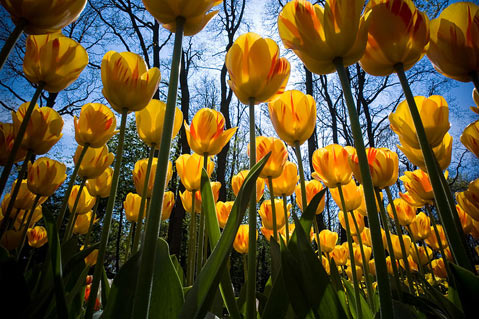Room to Grow
Space Plants Appropriately for Their Ultimate Size

Good designers take cues from nature and natural systems to create harmony in their work. Looking to native habitats can provide many insights, but one of the most useful ones is learning how to space plants appropriately for their ultimate size.
Environmentalists use terms like “mosaic” and “patchwork” to describe the spacing that happens naturally through competition for nutrients, light, and water. There are obvious benefits to this arrangement that can be replicated in gardens. The key is to place plants in relation to each other to allow maximum space for their mature size. They will require less irrigation, fertilizer, and little or no pruning for size, although occasional pruning for shape may still enhance their good looks.
Whether the garden area mimics the natural mix of annuals, perennials, shrubs, and perhaps bulbs that would occur in many native sites or is made up of totally exotic species, the simple rule to follow is knowing how big the plants will grow and providing adequate space for that development. There are several ways to achieve that ideal. The most obvious is to plant at just those generous parameters and wait for the garden to mature. Very few of us have that kind of patience, so the next best way is to avoid large empty holes by filling them with temporary place-fillers. Annuals are good candidates to sprinkle about between the more long-lasting species.
Perennials and woody shrubs require the most care in placement. Do read the tags or look them up in a good garden encyclopedia to decide how far apart they should be planted. These are the ones that can’t be easily edited out later (although it can be done if necessary). So, start with the skeleton, the larger and more permanent plants. In between them, create swaths or rivers of colorful annuals or even grasses that can be removed as the stars grow. Be fearless when the time comes and the result will be better than could be imagined.
Many annuals can be easily grown from seed. Prepare the soil by digging and raking to a fine texture. Since the seeds of a lot of these species are tiny, broadcast them and plan to let only some of them reach maturity. Mist often until seedlings are established, gradually deepening the watering to encourage good root systems that will resist wilting as days get warmer. As they grow, selectively pull young plants to create enough space around them for maximum growth. When the season is over, it will be almost painless to toss them on the compost heap and reassess the overall design.
If bulbs fit in the scheme, they can be tossed out more or less at random and then planted to the appropriate depth wherever they landed. Lots of bulbous plants can tolerate a little crowding, and having some clustered together will add to the natural look. They also add to the seasonality of the landscape. There are bulbs that bloom in spring, summer, and fall, so choosing different ones for each season will spark interest, too. Space out, literally, by taking a tip from nature.



